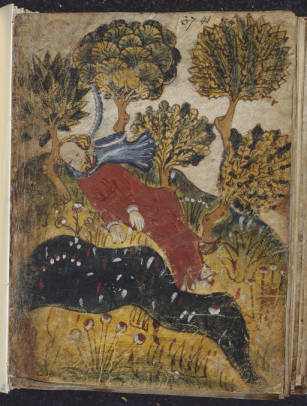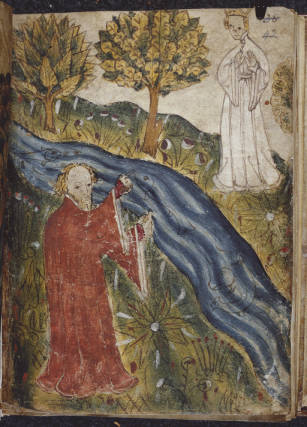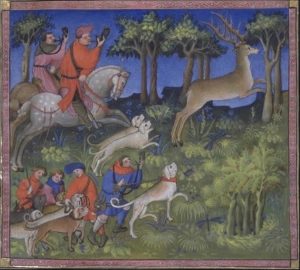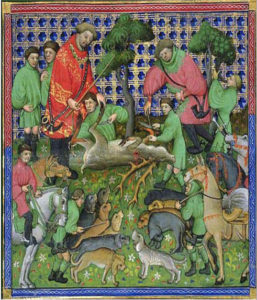[This post, part of an effort to merge our undergraduate and graduate blogs, was written in response to an essay prompt for Kathryn Kerby-Fulton's undergraduate course on "Chaucer's Biggest Rivals: The Alliterative Poets." It comes from the former "Medieval Undergraduate Research" website.]
Original:
Perle plesaunte, to prynces paye
To clanly clos in golde so clere:
Out of oryent, I hardyly saye,
Ne proued I neuer her precios pere.
So rounde, so reken in vche araye,
So smal, so smoþe her sydez were;
Queresoeuer I jugged gemmez gaye
I sette her singeley in synglure.
Allas! I leste hyr in on erbere;
Þurȝ gresse to ground hit fro me yot.
I dewyne, fordolked of luf-daungere
Of þat pryuy perle withouten spot.
Translation:
A pearl lovely and pleasing to a prince
To purely enclose in gold so clear:
Out of Orient, I hardily say
Proved I never her precious pair.
So round, so noble in each setting,
So slender, so smooth her sides were;
Wherever I judged splendid jewels
I set her singly in uniqueness.
Alas! I lost her in one garden;
Through the grass to the ground it slipped from me.
I pined, grievously wounded of distance from my beloved
Of that privy pearl without spot.
The first stanza of any poem functions as the foundation for the key themes that a poet then explores and expands upon throughout the remainder of the text. In the case of Pearl, within twelve lines, the poet alludes to Catholicism, creates layered language with literal and figurative meaning, and establishes an active first person narrator. All three topics serve as the basis of understanding the poem, and the reader can only comprehend their importance because the poet emphasizes them at the beginning. However, in Marie Borroff’s translation, her word choice removes the most important aspects of the opening stanza, and so one cannot trace these overarching themes.
Borroff actively eliminates the first person narrator in the opening section of the poem, and by doing so she removes the individualized nature of the Dreamer’s journey. In lines three and four, the original poet wrote, “Out of orient, I hardyly saye,/ Ne proued I neuer her precious pere.” Instead, Boroff translates the line as, “Boldly I say, all Orient/ Brought forth none precious like to her.” She places the motivation of the action behind the personified “Orient.” The original stated that the “I” never “proued” or proved a match as precious as his pearl. In the translated version, the reader does not understand the narrator, but in the original the Dreamer clearly performs the action.

Borroff continues to diminish the important individualized nature of the Dreamer when she says, “Ever my mind was bound and bent/To set her apart without a peer.” (7-8). The original poet says, “Queresoeuer I jugged gemmez gaye/I sette her singeley in synglure.” The “I” executes the actions, as he is the one who “jugged” and “sette.” On the other hand, Boroff does not include the word “I.” Remvoing the power of the first person narrator shifts the power dynamic of the poem. Even when Boroff maintains the “I,” she structures the sentence in order to stress the direct object instead. For example “I dewyne, fordolked of luf-daugenere” (11), or what could be translated as I pined, grievously wounded of distance from my beloved, becomes “Now, lovesick, the heavy loss I bear” (11). The “heavy loss” acts the focus of the line, and the reader fails to notice the “I” between the powerful words of “loss” and “bear. Since the poem focuses on one man’s individual religious journey, to diminish his role is to lessen the impact of the poem.
At the opening of the Pearl, the speaker does not immediately declare who or what this pearl may be. It functions both literally as an object and also as a representation of someone. The reader understands the metaphoric meaning of the pearl because of the poet’s use of courtly language. He describes it as “So rounde, so reken in vche araye,/So small, so smoþe her sydez were” (5-6). The Dreamer characterizes the literal pearl as “round” and “smooth,” but allegorically these descriptions draw upon what Andrew and Waldron call “stock epithets used in courtly literature to describe beautiful women” (53). The poet continues to use this literal and figurative language up until he explicitly labels the maiden with the pearl: “Oh perle,” quoþ I, “in perlez pyȝt,/Art þou my perle þat I haf playned,/Regretted by myn one on nyȝte? (241-243). Even though the reader easily figures out that the pearl functions as a metaphor of some unidentified character, the poet specifically uses images that keep the reader guessing about whether or not this pearl is literal as the poet also describes an actual object.

Borroff translates some of the first stanza lines as “So comely in every ornament,/So slender her sides, so smooth they were” (5-6). She removes the mystery of the pearl by translating “round” and “reken” as “comely.” The word comely typically describes a woman, not a pearl and so Borroff eliminates the layer of allegory of the metaphorical depiction of the maiden. Her translation forces us to understand the pearl as a woman, not as a literal object. However, the reader must also understand the pearl literally, as it functions religiously. The poet alludes to the “pearl of great price” in the Gospel of Matthew. By focusing only on the courtly description of the Pearl, Borroff fails to convey the multiple allegorical meanings of its presence.
Throughout Pearl, the poet alludes to Christianity and to the Bible, especially once the Maiden enters the story. Eventually, the Maiden brings the Dreamer to see the heavenly Jerusalem and explains salvation to her father. Yet, the poet stresses the importance of religion with the very first stanza. The poet states,“Allas! I leste hyr in on erbere” (9), meaning that he lost her in a garden. While gardens could function as a symbol for love and romance, medieval authors also associated them with the sacred. The image of the garden harkens back to the story of creation and the earthly paradise. Therefore, “erbere” represents a literal garden, a place of romance, but most importantly the Garden of Eden. Borroff translates that line as, “In a garden of herbs I lost my dear” (9), which is a correct paraphrase. However, by choosing a translation with the phrase “of herbs,” Borroff implies that this garden is literal and so she fails to convey the religious allegorical level of the garden.

The poet continues to allude to Christianity with the line, “I dewyne, fordolked of luf-daungere” (11). Andrew and Waldon state, “The whole line is perhaps reminiscent of the phrase quia amore langueo (‘for I am sick for love’). The Song of Songs, from which this phrase comes (2:5, 5:7-8) was interpreted spiritually as the soul’s longing for Christ” (54). While the poet created the phrase “luf-daungere,” he connects the connotation of his idiom with words in the Bible. On the other hand, Borroff fails to express the religious connotation with her translation: “Now, lovesick, the heavy loss I bear” (11). While the Dreamer does bear his loss, Borroff’s translation focuses too heavily on the loss itself, rather than on the emotion of longing. “Lovesick” does not effectively signify the spiritual importance of his deep desire to be reunited with the pearl.
Marie Borroff attempts to balance creating a translation, maintaining alliteration, and conveying meaning throughout her translation of Pearl. While I believe her work efficiently communicates the literal text, levels of deeper understand and allegory become lost in translation. A reader can only understand these important themes by returning to the original text, and placing the poem in its context.
Elizabeth Miggins
University of Notre Dame
Works Cited
Andrew, Malcolm, and Ronald Waldron. The Poems of the Pearl Manuscript: Pearl, Cleanness, Patience, and Sir Gawain and the Green Knight. Exeter: U of Exeter, 2007. Print.
Borroff, Marie. The Gawain Poet: Complete Works: Patience, Cleanness, Pearl, Saint Erkenwald, Sir Gawain and the Green Knight. New York: W.W. Norton, 2011. Print.





